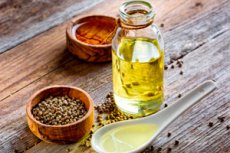New publications
Rapeseed diacylglyceride oil may fight obesity by improving lipid metabolism
Last reviewed: 02.07.2025

All iLive content is medically reviewed or fact checked to ensure as much factual accuracy as possible.
We have strict sourcing guidelines and only link to reputable media sites, academic research institutions and, whenever possible, medically peer reviewed studies. Note that the numbers in parentheses ([1], [2], etc.) are clickable links to these studies.
If you feel that any of our content is inaccurate, out-of-date, or otherwise questionable, please select it and press Ctrl + Enter.

Canola oil is a widely used vegetable oil, but excessive consumption may contribute to obesity. A recent study published in the journal Nutrients examines how canola diacylglycerol (RDG) oil, used as a functional fat, may affect fat accumulation and metabolism in a mouse model.
Obesity is the excessive accumulation of fat due to chronic and excessive energy intake relative to energy expenditure. Obesity is associated with a variety of diseases, including type 2 diabetes, hypertension, cardiovascular disease, and several types of cancer.
With the prevalence of obesity rising, researchers estimate that about four billion people could become obese by 2035. Obesity prevention is therefore an important area of public health research.
There are three types of adipose tissue: white adipose tissue (WAT), brown adipose tissue (BAT), and beige adipose tissue. WAT is an important source of triacylglycerol (TAG), the end product of fat digestion after excess energy intake.
BAT and beige adipose tissue are metabolically active and allow energy to escape as heat. This heat is produced by non-oxidative uncoupling, which in turn leads to increased glucose uptake by fat cells and increased lipid metabolism. Thus, activation of these forms of adipose tissue may be important in correcting the metabolic imbalances of obesity.
"Reducing WAT and increasing BAT is critical to enhancing lipid metabolism and preventing obesity."
Oils in the human diet
Oils are an important source of essential fatty acids, vitamins, and other fat-soluble nutrients. However, excessive consumption of oils in food increases the risk of obesity.
Diacylglycerol (DAG) is found in small amounts in natural oils. It has been suggested as a healthy replacement for TAG-rich oils because DAG is not converted to TAG or TAG-chylomicrons, which are associated with obesity.
TAG is converted into chylomicrons in the small intestine, and they accumulate in adipose tissue. In comparison, DAG provides energy and regulates fat metabolism, improving insulin sensitivity, regulating blood lipid levels, and reducing visceral fat.
DAG may also reduce the risk of abnormal blood clots and certain cardiovascular diseases, such as high glucose and lipid levels. In addition, DAG improves fat digestion by promoting the release of fatty acids in the intestines.
Rapeseed oil is the main vegetable oil in China and is composed of unsaturated fatty acids. RDG is therefore poised to replace conventional vegetable oils, including rapeseed oil, in oil-rich foods. This was the motivation for the current study, which compared the efficacy of RDG with rapeseed triacylglycerol (RTG) oil on obesity-related parameters and clinical syndromes in obese mice.
About the study
The current study compares serum glucose levels in obese mice in a high-fat diet trial. In the RDGM group, mice were fed a high-fat diet (HFD) for eight weeks, followed by 12 weeks of RDG, with 45% of total energy from RDG oil.
For the RTGM group, which included mice that were also fed an HFD for eight weeks, followed by 12 weeks of RTG, the control group received a control diet for 20 weeks, the high-fat diet (HFD) group, and the RDG group, which received an RDG diet for 20 weeks, were also included in the analysis.
All groups except the control group received 45% of their energy from the oil. After eight weeks, all groups showed an average increase in body weight of 20% compared to the control, indicating that obesity had been achieved.
Benefits of RDG for Obese Mice
Obese mice in the RDGM group had lower fasting glucose levels than those in the RTGM group. Blood ketone levels also decreased, indicating a reduction in metabolic load. Serum triglyceride levels in the RDGM group were also 26% lower than those in the RTGM group.
The RDGM group showed significantly slower weight gain compared to the RTGM group. Mice from the RDGM and RDG groups also showed a decrease in WAT index and became thinner than mice from the RTGM group.
The liver size of the RDG group mice was similar to the control, while the RTGM group mice had the largest liver, followed by the RDGM group mice. The liver structure showed favorable changes after RDGM intervention compared with RTGM, indicating improved lipid metabolism in both the intestine and liver. Triglyceride levels were reduced in the RDGM group mice compared with the RTGM group, however, the high-density lipoprotein (HDL) and total cholesterol levels were similar.
Transcriptional effects
Transcriptional effects were also observed in the RDGM group. Decreases in the expression of peroxisome proliferator-activated receptor γ (PPAR-γ) and diacylglycerol acyltransferase (DGAT) genes, which are associated with fat accumulation, were observed in the intestine and liver. Specifically, PPAR-γ expression in the liver and intestine was reduced by 22% and 7%, respectively, compared to nearly 40% and 47% for DGAT, respectively.
Fat breakdown in BAT remained unchanged, with minor changes in lipolytic gene expression. This observation suggests that RDG-induced changes in adipogenic gene expression result in decreased white fat deposits with smaller fat cell sizes.
RDG consumption has been associated with greater gut microbial diversity. Changes in species may improve lipid metabolism, leading to beneficial effects.
Conclusions
Dietary intervention with RDGM in obese mice was associated with beneficial effects including improved body composition, reduced obesity-related indices, a more diverse gut microbiome, limited adipogenesis, and improved lipid metabolism in several key tissues.
Because RDG has the potential to reduce liver damage and regulate cholesterol metabolism, this relationship suggests that RDG consumption may regulate lipid metabolism.
